 |
  |
 |

Dialogue with the demons of the tools. Buffalo 1973 - 1979
|
 |
|
|
Steina and Woody Vasulkas belong to the the first generation of video makers. The excerpt from the monographic study Dialogue with the demons of the tools. Steina and Woody Vasulkas (published by NAMU and JSAF / Jihlava International Documentary Film Festival in October 2011) focuses on the relationship of The Vasulkas with their colleagues filmmakers at the university in Buffalo in the 1970s, Paul Sharits and Tony Conrad, as well as the "dialogue" and affinities between video and film.

Woody and Steina in front of an installation from Machine Vision cycle. Albright-Knox Gallery, Buffalo. Vasulkas Archive.

Woody Vasulka's cycle Descriptions. Albright-Knox Gallery, Buffalo. Vasulkas Archive.
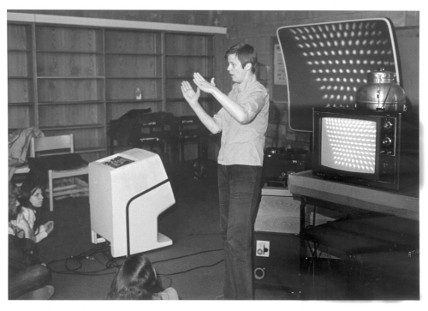
Steina at a lecture at SUNY in Buffalo, October 1975. Vasulkas Archive.
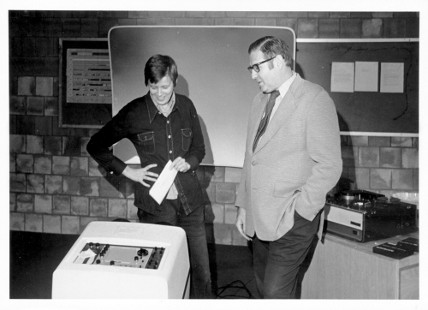
Steina and Gerald O'Grady at a lecture at SUNY, Buffalo, October 1975. Vasulkas Archive.
Media Study Centre
Gerald O’Grady, the founder of the Media Study department at the State University of New York in Buffalo, is a scientist with a large scope, his interests include linguistics, philosophy and media theory, but he also researches dreams or Afro-American movies. O'Grady has followed the work of Steina and Woody Vasulkas since 1972 when he met them in New York City. He defines his research method as a "spherical knowing", which includes all the senses and implements knowledge from various spheres. He compares it to a gunshot that is followed by an explosion, shattering the fragments, which should then be rearanged and further developed.1
The historical period of Media Study Buffalo, which was called “one of the most elaborate and comprehensive media programs in the world”2 in one article then, was the subject of the MindFrames exhibition, prepared by The Vasulkas together with Peter Weibel and another collaborators for ZKM in Karlsruhe, which took place in 2006-2007. This large audiovisual display was dedicated to the period 1973-1990, when structuralist filmers Paul Sharits and Hollis Frampton, documentarist James Blue, musician and filmmaker Tony Conrad were employed, and later Peter Weibel, who replaced Woody in his professorship position. In 2008 the exhibition catalogue was published, assembling the texts of the participating artists; some of them published for the first time ever.3
In Autumn 1973, after eight years, The Vasulkas leave New York City for Buffalo, an industrial city at the eastern coast of the lake Erie not far from Niagara falls, where Woody gets job at the university. Affiliated with the university was a community centre, providing technical equipment, and organizing concerts and film and video screenings and summer workshops for young people from New York State who studied video, photography, holography, electronic music or computer imagery. Some of the workshops were tought by Steina who also helped Woody with lecturing. The Buffalo period was important for Vasulkas work, because suddenly they had more time and resources for developing the ideas from the previous years. Many of their works thus have as the date of creation the first year they spent there. Especially from 1974 they began to edit and structure their older works, while they choose the "Tapes in Distribution" for public presentation from the original "Raw Tapes", including more than 300 hours of video from 1969-1978. Also in this period their work begins to separate. Steina concentrates more on creating the installations dealing with space and time phenomena and "machine vision", when she posits the camera on motor driven tripods or objects, and performances involving violin play (especially Violin Power cycle), while Woody plunges into theory and praxis of electronic image and creates didactic works of "practical philosophy". On the other hand, although they both claim they have worked apart since 1975, they keep sharing their working and living environment as well as their tools.

Vasulkas' Loft Buffalo. Vasulkas Archive.

Steina at Loft Buffalo, ca 1975. Vasulkas Archive.

Window view from the Loft Buffalo. Vasulkas Archive.
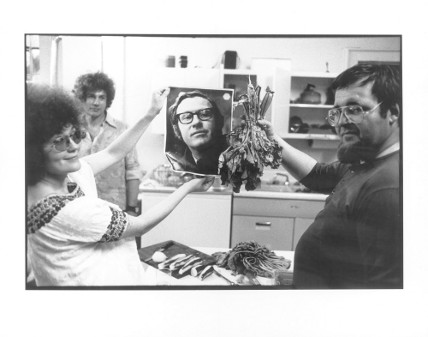
Georgiana Jungles and Woody Vasulka with a portrait of Gerald O'Grady and James Blue. Loft Buffalo, 257 Franklin Street, ca 1976. Vasulkas Archive.
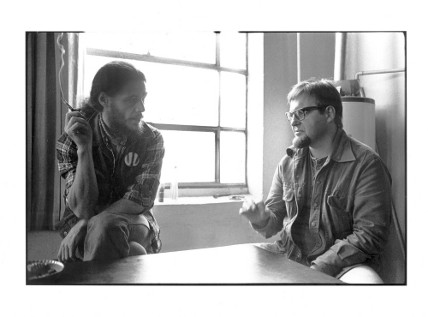
Phil Morton and Woody Vasulka, Loft Buffalo, 257 Franklin Street, late 1970s. Photo Jane Veeder. Vasulkas Archive.
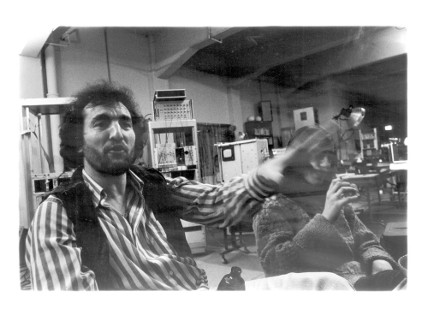
Paul Sharits and Boyana Dedier. Loft Buffalo, 257 Franklin Street, late 1970s. Vasulkas Archive.
"Practical philosophy"
An endeavor to summarize the up to now experiences with electronic material is documented also in the transcript of the lectures, which Woody delivered during five May evenings in 1976.4 The original recordings are kept in Langlois Foundation in Montreal, available is the transcript created by John Minkowsky. "Whatever I say you can doubt, but listen to it," proclaimed Woody Vasulka at the beginning and perhaps wanted to suggest that he would present the ideas in the moments of its birth, illuminating thus his own creative process. His aim was to find a new language for analysing the electronic image. After the period of initial experimenting, it was necessary to rethink and redefine the basic postulates of the creative process. The attempts at a "practical philosophy" were formed by a cybernetic-like observing of the process of your own development while working with technology. The Vasulkas - in accordance with the endophysical concept of creating the models for observing the observance (individuals or machines) - played with the idea of acquiring the tool for an all-seeing model of the space, which would enable them to navigate their electronic steering wheel into the oceans of a different consciousness.
As it was already implicated, Woody Vasulka understands electronic image as an enlargement of film, existing in a different time sphere, where the synchronization process as a condition of the image existence has to be taken into account. Film as well as electronic image involves the process of frame forming, but while in case of film the frame is basically a static even, in case of electronic image it is generated from within and has a special relation to the time structure. While in film the parallel process of exposition takes place, in case of electronic image the frame emerges from continuously proceeding sequences of image scan lines. That is why electronic image can be treated in such an "interactive" way, which in film is impossible.5
The relation of electronic image and experimental film is explained especially by pointing out to the work by Paul Sharits and British avant-garde filmmaker Malcolm LeGrice, who both experimented with recurrent recording of the film stripes projected in various speeds in their desire to emancipate themselves from the regularity of sequentiality of film frames. For example Woody perceived that associations evoked by the "pure" acetate, meaning the film stripe without the image recorded, are not more materialist or non-illusionistic that others, and the film event is not necessary demystifyed by this, as some of the theoreticians of materialist or structuralist film presupposed. Film, even when "empty", thus even if it is a pure film stripe, still contains the frame, which is precisely localized during the projection. We could make parallels between the "organizing" of film and electronic image: while in film it is the „imprint or fixed modulated expression of light-space in front of the camera“, in case of video we deal with the „modulation, or energy content of electronic image“.6 A radical example of such an "empty" film is Zen for Film by Nam June Paik (from 1962): clear, not exposed film stripe stuck together into a circle was projected in loop again and again. During the repeated projections it was gradually receiving its "content" in the form of acumullated dust, and another marks of previous projections. It thus testified also about the interface between the statement on the film stripe and the fact of projection itself.
Buffalo university milieu offered a breeding-ground for the dialogue of filmers and video makers. Although, according to Gerald O'Grady, there was a scepticism towards accepting the video artists as members of the department from the side of filmers, because none of them was interested much about video initially, and even later there was not a common program or more intensive dialog in this community of distinctive individualities. However, a certain kindship certainly existed there. Hollis Frapton dealt with the digital creation, and even together with Woody led a digital workshop, which was related to his life-long interest in science and the use of programability in the arts. On the other hand it was an obsession to search for some base units, an "essence" of (cinematographic) media, and an effort to create a self-contained reality, independent on the surrounding world, which connected Woody with Paul Sharits. In the program statement from the festival of experimental filmmakers in Knokke-Le-Zoute in 1967 Sharits notes, that he wants to abandon "imitation and illusion" and enter „directly into the higher drama of: celluloid, two dimensional strips; individual rectangular frames; the nature of sprockets and emulsion; projector operations; the three dimensional reflective screen surface; the retinal screen; optic nerve and indivudual psycho-physical subjectivities of consciousness.“. He stresses the use of light as energy for creating virtual forms and involvement of actual movement, space and time.7
In case of Sharits, the main object of film vision became the material aspects of media, normally hidden during the projection: film perforation, flatness of the screen, single film frames. He called his working method "abstract narrativity", and it can be compared to Woody's "one scan journey". Paul Sharits is considered a key proponent of the so called "flicker film", which uses the series of repeated film frames generating the flickers in various rhythms and intensities. Sharits also visualizes film structure in his static images series: for example Frozen Film Frames from the 1960s and 1970s consist of the series of "frozen" film frames. Inspired by Sharits' work and in the desire to create its analogy in the digital sphere, Woody attempted to construct a machine for dealing with the coloured frames that could be used by Paul Sharits. He found a time setting machine at the Horseheads, New York, dum, the part of which was a stroboscope; he made a machine out of it enabling to launch colors from RGB filter and create sequences from them. The algorithmical program was created by another member of Buffalo group Tony Conrad. According to Woody, Sharits was uniterested in the machine, because he prefered hand-making of the coloured scores with the ball-point pen, as a base for creating the films.8 Woody came back to the idea of the machine during preparation of the exhibition in ZKM in Karlsruhe, where with the help of Robert O'Kane9 prepared the program for generating the colors based on the Paul Sharits' working method. The question "what happens in between the frames" fascinated Woody as well as structural filmmakers: while these were operating in the area of film frames, in case of video the flexible formation of single frames becomes the subject; the way of thinking is in many ways analogical and for example the above mentioned Noisefields (1974) by Vasulkas can be considered as an analogy of flicker film created in video.
An alliance could be also found also with the work of Tony Conrad. The electronic music composer, sound artist and structuralist filmmaker is as the only one from the Buffalo group still employed in Buffalo, at the media studies department. His early minimalistic work was influenced e. g. by the work of La Monte Young, Conrad was the member of Theatre of Eternal Music, later renamed to The Dream Syndicate (together with John Cale, Angus MacLise, La Monte Young and Mariane Zazeela): harmonically linked, prolongated tones are typical for their dream music, with the consonanses based on the experiments with just intonation.10 Conrad's early movie Flicker (from 1966) is considered as one of the founding works of structuralist film movement. Thirty minute long film is created purely by planes of black and white non respecting the limitations of actual film frames, while its algoritmic ordering evokes a hallucinatory impression. The audio track was created on a home made electronic tool, generating continuous scope of clicks similar to metronome sound, and dealing with the relations of rhythms and tone pitches. The rhytmical film structures evolve from the basic rhythm of the projection frequency.11 The visual structure is analogical to music, each pattern suggest an "accord" of three allied frequencies, so that it is an extension of the harmony principle into visual sphere, an analogy of "visual music". Flicker film is for Tony Conrad a way how to overcome the limits of the cinematographic apparatus. Similarly as in case of another representatives of structural film there is a contrast of an overall calculated structure and its actual unfoldment during the projection.12 The work by structuralist filmmakers can thus be perceived as in parallel and allied to the early video art, these two areas are - despite of the different medium - closer than it might seem. The theory and praxis of structuralist film was to a large extend influencing the way how Woody Vasulka reflected about his work.
|
poznámky a odkazy k článku
1 From the interview of the author with Gerald O’Grady, October 12, 2005 in Boston.
2 Mooney, Karen. Gerald O’Grady: The Perspective from Buffalo. Videoscop. 1977, Vol. 1, No. 2.
3 Vasulka, Woody; Weibel, Peter (eds.). Buffalo Heads: Media Study, Media Practice, Media Pioneers, 1973-1990. The MIT Press, 2008. The unique feature of the exhibition was the fact that all the audiovisual materials were projected from one control server; The Vasulkas tested here a new way of a "distance" exhibiting.
4 Already in 1974 Woody had a series of public lectures – an invitation titled Three Lectures by Woody Vasulka is preserved – divided into parts Electrons: The Art Material, Time Structure of Electronic Image, The Television Myth; it is not known to me if some record or transcription exists. [online]. Available from http://vasulka.org.
5 Five Lectures. In: Vasulka, Woody; Weibel, Peter (see note 3).
6 Ibid.
7 Sharits, Paul. Notes on Films/1966–1968. Film Culture. 1969, č. 47, s. 13.
8 From the interview of the author with Woody Vasulka. The English version of the interview is published in the disertation. Dolanová, Lenka. Woody Vasulka. Dialog s démony nástrojů. Dizertační práce. FAMU, 2009.
9 Robert O’Kane also comes from the Buffalo circuit: he studies first electric engineering at the university, afterwords also media studies and music.
10 Just intonation is musical tuning in which the frequencies of notes are related by ratios of small whole numbers (source: http://en.wikipedia.org/wiki/Just_intonation).
11 It is in a way a storage of various flicker patterns: Conrad, who originally studied mathematics, considers for example the number of flicks and frames in the cycle or number of flashes per second. While normally the movies are projected in the speed of 24 fps, for the flickering effect the optimal speed is 6-16 fps. The alfa rhythm of the brain is located in the range of 8-16 cycles: this is why the films can cause epileptic seasures, and at the beginning of the Flicker movie there is a warning, that authors disclaim their responsibility for any physical or mental harm caused by the film.
12 In the book Beyond the Dream Syndicate: Tony Conrad and the Arts after Cage by Branden W. Joseph (The MIT Press, 2008) is one chapter dedicated to The Flicker.
ďalšie články autora
Dialog s démony nástrojů. Buffalo 1973 - 1979 27-28
|
   |
 |
 
<< < 1/1 > >>
|
 |
 |
 |
  |
 |
  |
 |
 |
©20023456789101112
atrakt art | emigre by
satori
|
|